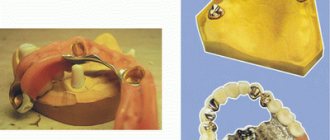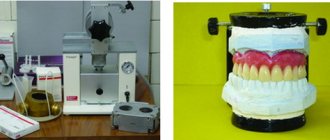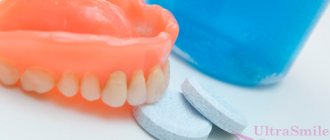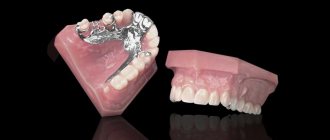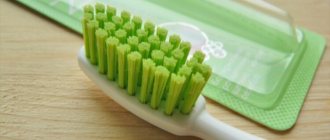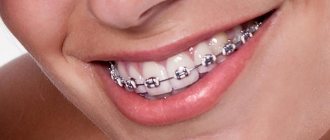How long can you wear without taking it off?
How to store? How to care? Whitening dentures Service life Dentures for many years You can restore the dentition in different ways, including removable dentures. They help restore the beauty of a smile, restore chewing function, and increase self-esteem. In order for restorations to retain their attractive appearance and last for several years, they must be looked after. Cleaning dentures and disinfecting them is an important part of care.
After installation, the dentist will definitely give recommendations on how to use dentures. He will warn that in the first days the restoration will interfere. It is necessary to prepare yourself psychologically and survive this time. It will become easier in a few days. Usually the hardest day is the first. Then a difficult 5-7 days
addictive, but they are not so intense. During this period, orthopedists advise not to remove the denture at night and generally remove it from the mouth only for cleaning.
These days, the patient practices his skills of taking off and putting on dentures, speaking when the tongue is cramped in the mouth, and chewing with unusually high teeth.
How long can you wear a prosthesis without removing it?
It is believed that the adaptation period has come to an end when the patient without dentures becomes uncomfortable. He already knows how to quickly put them on, they do not interfere with speaking, and are involved in chewing food. The period when it is better not to remove the structure is ending. Now you can take it out, but how often?
The standard recommendation is to remove the dentures at night to give your gums a chance to rest. If the denture is not removed, the hygienic condition of the oral cavity deteriorates. However, modern dentistry is characterized by an individual approach, so how often to remove dentures depends on specific circumstances. For example, with removable prosthetics, it is important how many antagonist teeth remain. In some cases, a prosthesis helps protect the remaining teeth from traumatic occlusion (touch) and overstrain. Do not remove splinted structures or restorations due to arthropathy and bruxism
[1].
The side effects of restoration can be compensated for by using prosthetic products without a palate and frequent cleaning.
Basic rule:
The less often the patient removes the prosthesis, the more carefully it needs to be looked after.
Complications in case of untimely replacement
If you visit the dentist irregularly or endure pain for a long time, then dangerous complications are likely to occur, such as gum loss, local periodontitis, marginal periodontitis, tooth decay, the appearance of cysts and granulomas at the roots, peri-implantitis - inflammation around the implant. All these conditions are fraught with removal of the root/implant and prolonged recovery (if the bone was severely infected).
PROSTHETICS WITH 6 OSSTEM IMPLANTS FROM RUB 220,000.
Complex implantation Osstem (South Korea) with delayed loading after 4-6 months.
Call now or request a call
“I somehow missed the moment that the crown began to wobble, so I didn’t go to the dentist. But a few days later, during lunch, I felt that it had fallen off altogether. Almost swallowed it! I thought it would be possible to glue it in place. But the prosthetist said it was too late, the root was cracked and needed to be removed. Here. So now I’ll have to make a bridge or an implant. Not decided yet". Sergey, review from the website stomatology.rf
Foods to avoid
Proper care of dentures also means that you need to treat them with care. During the first time after installation, patients have to slightly change their diet. Although most foods will gradually return to your diet, some of them should be abandoned altogether. These are solid products: crackers, nuts, seeds, dried bread and bagels. Classified as unwanted
include toffee, nougat, and chewing gum. It is better to avoid food that is too hot to prevent cracks in the base.
At first, it is better not to bite off anything at all, then bite off with the side group of teeth, gradually moving to the front group.
It is important to chew food slowly, making sure that the chewing load is distributed evenly on both sides.
Tea, coffee, red wine and dark berries create conditions for discoloration of restorations. This should also be kept in mind when choosing drinks and food.
This is especially true for acrylic plastics. They are permeated with micropores in which pigments easily accumulate. More modern materials such as Acry Free or QuattroTi are dye resistant.
What experts recommend
To avoid complications and install a high-quality, durable prosthesis, you need to contact an experienced orthopedist who will conduct a full examination before prosthetics and model an anatomically correct design. It is also important that the support is properly prepared - the canals are thoroughly cleaned and sealed, the upper part is sharpened, and a suitable implant is selected. To restore teeth, today they offer several methods for making crowns, and the optimal one is milling using CAD/CAM technology. This results in very tight-fitting structures, under which germs and food particles do not penetrate, so they last longer than others.
How to store
The best place to store dentures is in a special container. As a last resort, you can put it in a glass of water or wrap it in a damp cloth. To store dentures at night and between uses:
- away from children and animals;
- in a special solution or cooled boiled water. Do not immerse in boiling water or tap water, which contains many impurities.
Whether to place the product in water or a special storage solution largely depends on the material
. Modern thermoalloys do not need a humid environment, but classic acrylic ones can dry out without water. Your dentist will advise you on how to properly store dentures, taking into account the material of construction.
How to care for dentures
A side effect of removable dentures is a change in the microflora of the oral cavity. Because of the prosthesis, the palate and gums stop cleaning themselves. Bacteria accumulate in the mouth, especially at the points of attachment to the crown of the tooth, if the structure is partial. The longer a restoration is used, the more it is exposed to biocontamination.
Proper care has a great impact on the service life of removable structures. It is multi-stage, but in reality it does not require much time and effort.
In dentistry, there are mechanical, chemical, and physical methods of cleaning restorations.
Mechanical cleaning
carried out with a special toothbrush. The fact that it has bristles on both sides helps to effectively clean removable dentures from plaque. The longer one is for processing the outside, and the short one is for the inside. The heads are either straight or crescent-shaped.
An orthopedic dentist will definitely tell you how to clean your dentures. The brush should be soft, usually written “soft” on the packaging, and the paste should be low-forming. The abrasiveness coefficient is indicated on the packaging under the letter RDA
.
For nylon and Acry Free bases, it is best to choose a paste with zero abrasiveness
. These are produced for children under 3 years of age. Instead of toothpaste, you can use liquid soap.
Acrylic bases can be cleaned with a paste with an abrasiveness of up to 25
. For ordinary pastes, this coefficient is 60 or higher. Whitening pastes are not recommended.
Chemical cleaning
- This is soaking in disinfectant solutions. The structure is immersed in the prepared solution or a special tablet is added to the water. Such products are sold in pharmacies. The most famous brands: Corega and Protefix. These products destroy bacterial plaque, which can cause diseases of the mucous membrane and cause an unpleasant odor from the prosthesis. After being in the solution, the structure emits a pleasant aroma.
However, in case of heavy contamination, such disinfection does not provide 100% cleaning. If a layer of pigment or tartar has formed on the product, home care tablets for removable plastic dentures will not help. Here they use polishing at the dentist or ultrasound.
Physical cleaning
Ultrasound is suitable for complete dentures made of any material. Ultrasound passes through the liquid, creating bubbles on the surface of the restoration, which, when bursting, help clear plaque on the dentures, clean them of food debris and dirt, even from hard-to-reach places. 10-20 minutes in such a bath and not a trace remains of bacterial plaque. The higher the power of the ultrasonic bath, the better it cleans the surface.
After each meal, it is recommended to rinse the restoration under running water. The cleaner the denture, the more comfortable it feels in the mouth. A structure covered with plaque and stains wears out faster. In addition, dirt and bacterial film provoke inflammatory processes in the oral cavity. With proper and regular use of cleaning products, restorations retain their attractive appearance for a long time.
If the structure has become dull and shows signs of pigmentation, you can contact your dentist and he will send the denture for polishing.
Your questions and answers
QUESTION Is it possible to exchange a crown (more precisely, a bridge) for an implant and two crowns on the sides? The old bridge is shaky, and for some reason I didn’t like it. The front teeth don't look very good. Dmitriy
ANSWER Dmitry, without the results of an x-ray examination it is quite difficult to answer your question in the affirmative, because It is unknown what condition the supporting teeth are in. If it’s good, then the option you proposed is quite possible. But here, most likely, the crowns on the “former” supports and on the implant itself will be placed at different times, since it will be necessary to wait for the implant to heal. But it is possible that while healing is ongoing, the dentist will place a temporary bridge on all three teeth. If now the supports are in unsatisfactory condition and they need to be removed, then they can put 3 implants - and a crown for each, or combine the implants with a bridge.
1Haug S. Correct modeling, 2006.
Author: Dulgarov Zh. G. (Thank you for your help in writing the article and the information provided)
Whitening dentures
Pigmentation and brown deposits can ruin the appearance of any restoration. Regular oral care with dentures prolongs the life of the dentures and maintains the aesthetics of the structure. But whitening pastes only cause harm. They contain too many abrasives that scratch the plastic. The surface of artificial teeth is not as strong as that of natural teeth and is easily damaged.
The acids in home whitening kits are simply dangerous. The reaction of their components with prosthetic materials can lead to unpredictable, life-threatening results.
To whiten dentures at home, it is better to use special products. For example, Corega whitening tablets. They carefully clean the surface without harming it, eliminate unpleasant odors and remove stains. The tablets slightly lighten artificial teeth, simultaneously destroying pathogenic microflora,
What are crowns
Dental crowns are caps that are fixed to a support. In most cases, this is a preserved tooth root, and the natural crown is partially or completely destroyed. Less commonly, an implant. Dental crowns are actively used in the creation of other orthopedic structures - removable dentures, as well as dental bridges. The latter consist exclusively of dental crowns and are used to restore several missing teeth in a row (usually no more than three or four).
Don't know what type of prosthetics to choose?
We will help in the selection, advise where to read more information and compare types of prosthetics.
Consultation with an orthopedic doctor in Moscow clinics is free! Call now or request a call
Working hours: from 9:00 to 21:00 - seven days a week
Life time
If you wear your denture correctly and take good care of it, it will retain its original appearance for a long time. But after a maximum of 5 years
it will still have to be changed. This is due to the fact that removable dentures do not stop bone loss. Over the years, the gums sag, the topography of the mouth changes and the prosthesis no longer fits. In the first years, correction and relining help, but over time, the changes become so pronounced that only a new prosthesis can save the situation.


